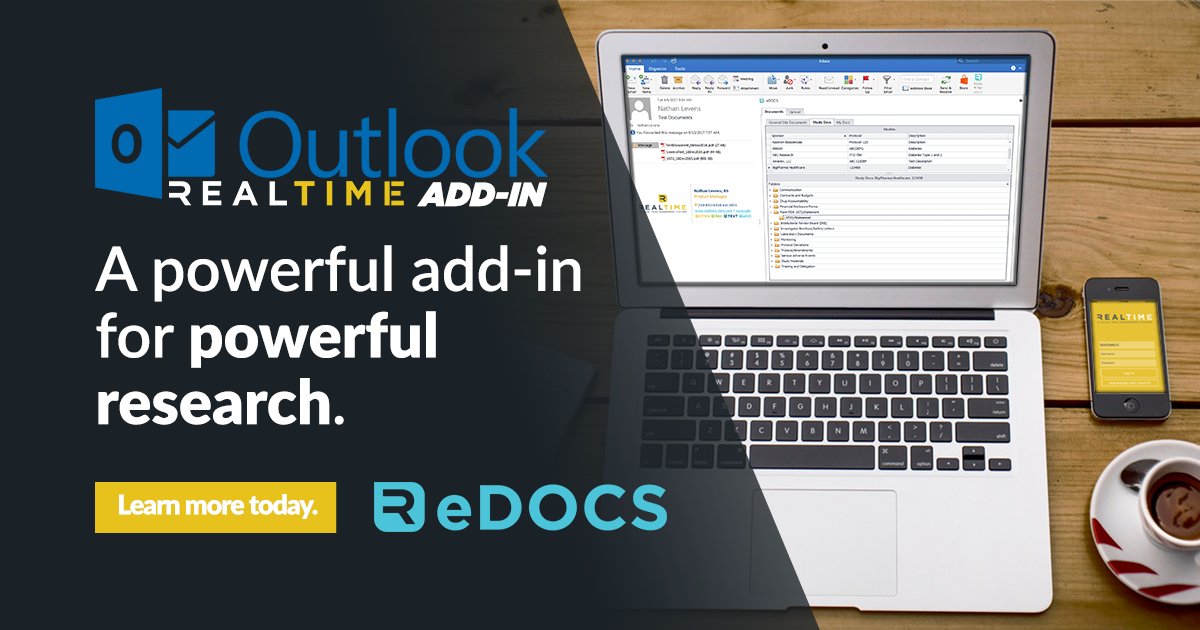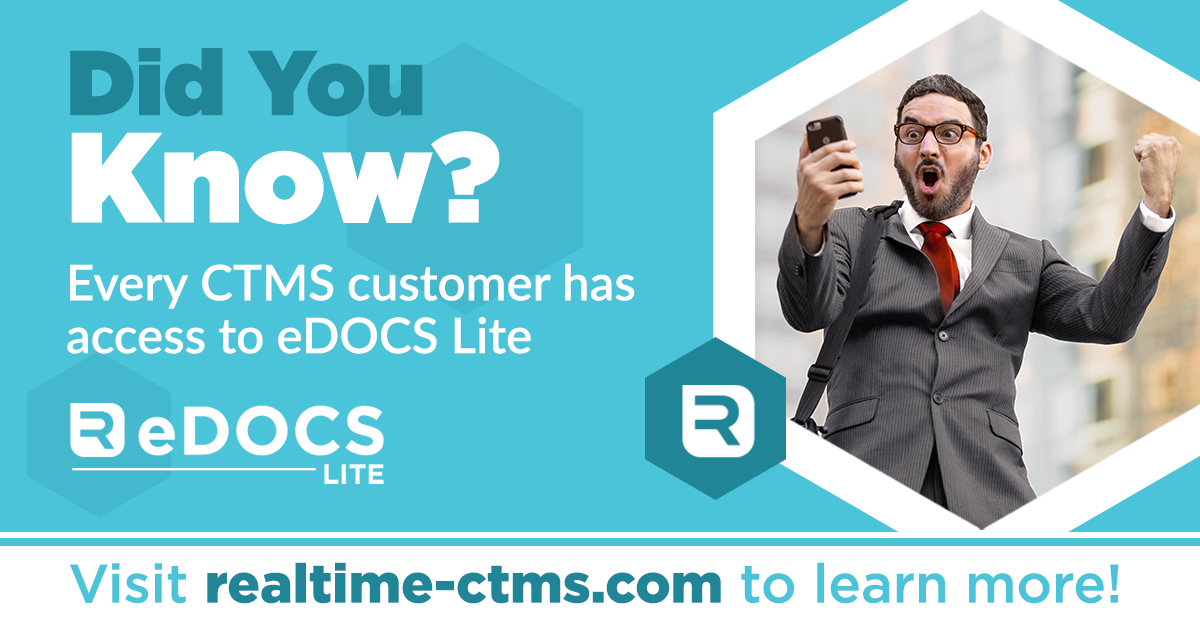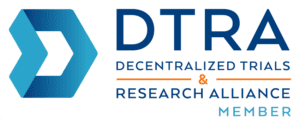Did you catch our webinar hosted by ClinEdge, “e-Regulatory Systems – Connecting Sites and Sponsors in a Whole New Way” from August? If not you can watch the recording here.
Nathan Levens answered several great questions during the webinar and received additional questions after the webinar ended. Below are some additional questions addressed after the webinar.
Q: Where does the “original” ink signature end up?
With Part 11 compliant electronic signatures, wet-ink signatures are no longer needed since the record can be signed electronically. Electronic signatures will create enormous efficiencies for your site. However, in the event that you do have a paper document with an original wet-ink signature, our system (RealTime-eDOCS) will allow you to scan that document as a certified copy. According to the FDA, certified copies are completely acceptable during an inspection or audit; therefore, your original wet-ink document can be destroyed. What you decide to do with your original paper document once it’s scanned and saved within eDOCS is up to your site’s standard process. The key is to establish a written SOP describing your process so that it’s clear to your sponsors and the FDA. While the most efficient process is to shred/destroy the document immediately after saving the certified copy, some sites decide to hold onto the wet-ink signatures and store them for a set time frame (e.g., 6 months down the road) or indefinitely. Simply do what’s best for your site.
Q: What is the percentage of sponsor’s/CRO’s that will allow sites to use eDOCs?
Your approach will greatly affect the number of sponsors/CROs that will share in the benefits of using eDOCS. Our experience has been that the sites that approach the utilization of eDOCS as a standard operating process within their organization are most successful. Since sites have every right to adopt an electronic system for their regulatory management, it’s important not to ask permission but simply let the sponsor/CRO know that this is the site’s uniform process.
To give you an example, one of our eDOCS customers who operates two successful sites has been utilizing an eRegulatory solution on 100% of their studies for greater than 18 months now. They have not lost a single study as a result their mandatory eRegulatory process.
To give you second example, another one of our sites is asking for permission to use their eRegulatory solution at the pre-study visit. By asking for permission, this give’s sponsors/CROs control over site processes. As you can guess, this strategy is far less effective and this site has received more push-back from sponsors/CROs.
It is important for sites to have a consistent and uniform process across all of their studies to ensure quality and compliance. The FDA paved the way for electronic systems to accelerate efficiency in our industry. It is not the sponsor’s place to dictate what systems sites should use for their site files as long as they meet FDA regulations. Further, sponsors often don’t understand the great benefits that come from utilizing these systems (i.e., remote access and monitoring, query tracking, increased collaboration, streamlined document review, etc.)
Sites around the world are already utilizing eRegulatory systems with great success and on 100% of their studies and this highly depends on the site’s approach.
Q: Can you give guidance on what to do when facing a sponsor who does not want to use a site because they use eReg
Please refer to the question above and develop a strategy. In the worst case scenario (less than 5%), the site can simply go with paper binders for that study; however, hopefully both you and the sponsor understand that this is a more costly way to go for both parties and will create inefficiencies by deviating from your standard process. Since you are stuck using paper in this scenario, nobody wins, including the sponsor, but at least you can keep business moving forward. Usually if a sponsor is not open to an eRegulatory system, it’s because they are not familiar with the benefits of the system to both parties; therefore, a strategy for articulating these benefits may change the sponsor’s mind. It’s good to ask them for the reasoning behind their decision against your eRegulatory system and lay out the benefits everyone will experience. From our observation, successful sites are those that engage the sponsor in meaningful conversation about why the site needs to use eDOCS to streamline processes for both the investigator and the monitor. During this conversation, sites can address the sponsor’s concerns and obtain buy-in. You can even offer to give the monitor a quick tour of the system so they can see the benefits it will bring. As a last ditch effort before deciding to go with paper, offer the sponsor a trial run to start the study electronic and mention that if they don’t like it for some reason then the site can quickly go back to paper. From our experience, showing sponsors the eDOCS monitor portal really helps obtain buy-in because it helps them visualize how the system will streamline their monitoring duties. The point is to try everything you can to give your sponsor a chance to get on board before resorting to paper. At the end of the day, eRegulatory systems will save the site and monitor valuable time which allows the research team to focus more on recruiting subjects and conducting visits, and allows the monitor more time to focus on subject data review, site training, and managing study resources. Everyone wins when sites make the shift to eRegulatory, but some sponsors need to be educated on this fact.
Q: Who needs to start the process? Do sites request from the sponsors?
Site-based eRegulatory systems reside at the site and the site starts the process of creating an eRegulatory binder and managing investigator records. All regulatory records that are received from the sponsor/IRB are uploaded to eDOCS by the site user rather than printing and filing into a paper binder. This eliminates the need for paper binders to manage the investigator site file. Once records are uploaded in the system, the site will issue web-portal access to monitors, auditors and FDA inspectors upon request to review the records.
Q: We are always at the mercy of what the sponsor wants. In our experience (we did a pre-test), sponsors do not want an “additional” system, and many of them require their system/portal. This is what seems daunting. I agree the problem should be solved at the site but what are others’ experiences in this? Sponsor requirements do not allow us to jump in with both feet.
Being “at the mercy” of the sponsor is a common feeling for research sites and I completely understand the frustration. Please know that while this is common, not all sites feel this way about their sponsors. The fact that some sites do not feel like they are at the mercy of sponsors shows that there is a way out of this trap and sites can absolutely take back control of their processes. This doesn’t mean that these sites never compromise with the sponsor, but it does mean that they fight diligently for processes that benefit their organization.
Furthermore, when a sponsor says that they do not want an “additional” system, it sounds like the sponsor doesn’t understand that a site-based eRegulatory system actually compliments their existing eTMF system/portal. This is a common misunderstanding by sponsors. From the webinar, I discussed that most sites still use the legacy system (paper-based binders) and upload copies of these paper records to sponsor systems/portals. What a site-based eRegulatory system does is replace the paper records with electronic records at the site. This allows sites to easily share the electronic files with sponsor systems/portals. Also, the monitor has the ability to download records straight from the site’s eRegulatory system to upload into their sponsor system. Nothing changes for the sponsor when a site uses a site-based eRegulatory system except the fact that they now have remote access to the records from anywhere with an internet connection. I have encountered this common misunderstanding when talking to sponsors at industry conferences. They ask, “Why do sites need eRegulatory systems when we already have an eTMF (electronic trial master file) portal that we provide to them?” The simple answer is that eTMFs are great for sponsors but do nothing to solve issues at the site-level. Sites are still having to find solutions to the paper-based investigator site files and a site-based eRegulatory system will provide these solutions.
Q: What should sites look for when evaluating eRegulatory systems?
The following are some items to keep in mind when shopping for a Part 11 compliant, site-based eRegulatory system; however, what matters the most is that the system truly streamlines your regulatory processes.
Check that the system truly reduces redundant filing for your site. Some systems don’t have a central location for common files and users still have to file the same records across multiple studies (i.e., CVs, GCP Training, etc.).
Ensure that the eSignature system is easy to use. Users should only be one or two computer clicks away from requesting signatures and/or signing a record. The process should be intuitive and quick.
Monitors should have a way to track what they have reviewed within the monitor portal and be able to issue queries to communicate to the staff. This creates a lot of efficiency for your monitors and staff. Plus monitors will be blown away at how the system makes their job easier.
Users should be able to customize their folder set up in their eRegulatory binders. This allows the site to create their own standard filing system and table of contents that works best for them. Have a standard filing system will create tremendous efficiency over time.
In regards to signing an agreement with an eRegulatory vendor. Some vendors will make you agree to buy a set amount of studies (about 5-10) up front which locks you into the system. If that system doesn’t work for you after trying it out, then you will still be locked in the agreement and owe money. Beware of contract that lock you into a trap.
One last thing is to ensure that the system has an Outlook integration feature. This will streamline your record management processes because users can categorize records, upload files, and sign records electronically without leaving their email inbox.
Q: Are sponsors paying for site-based eRegulatory systems?
As an eRegulatory system does represent an additional overhead cost, many sponsors are willing to consider providing additional compensation to help cover the cost of the system. Many sponsors do this knowing that the eRegulatory system will also provide efficiency and cost savings to them through streamlined monitoring processes and remote access to site files. This additional compensation can be provided as a specific line item, increasing start-up/closeout fees, or even an increase in the budget overhead percentage.
However, even if the sponsor is not willing to provide additional compensation, this shouldn’t be a determining factor when deciding to adopt a site-based eRegulatory system for a number of reasons. As I mentioned in the webinar, there are numerous hard costs and soft costs associated with paper-based regulatory processes that end up costing sites far more than the cost of an eRegulatory system. Also, the opportunity costs are extremely high! By streamlining your regulatory processes, your staff will be able to manage more studies from a regulatory perspective, plus your staff will gain more time to recruit participants and conduct study visits to generate more revenue for the site. Also, if your staff is spending less time on shuffling paper records, they will have more time to focus on subject safety and adverse event follow up to maintain subject safety.
As a side note, most sites are either increasing their overhead charge or archiving fees for each study to accommodate the new system if they want to ensure some reimbursement for their eRegulatory system. If the site’s overhead charge or archive fees are already relatively high and cannot be increased, then know that your new eRegulatory system is still streamlining your regulatory processes and decreasing your actual overhead over time and greatly reducing your need for physical archiving fees.
If you are interested in learning more about adopting an eRegulatory system to streamline your site’s regulatory processes, check out our industry leading product, RealTime-eDOCS™. We have the system features and industry experience that will take your site to the next level in efficiency.









 With Part 11 compliant systems now available for investigator sites to streamline processes, some of us are wondering what exactly is 21 CFR Part 11 and why is it important? Essentially, 21 CFR Part 11 regulations define the criteria under which electronic records and electronic signatures are considered trustworthy, reliable, and equivalent to paper records. Basically, Part 11 allows companies to replace any paper record or hand written signature with an electronic record/signature.
With Part 11 compliant systems now available for investigator sites to streamline processes, some of us are wondering what exactly is 21 CFR Part 11 and why is it important? Essentially, 21 CFR Part 11 regulations define the criteria under which electronic records and electronic signatures are considered trustworthy, reliable, and equivalent to paper records. Basically, Part 11 allows companies to replace any paper record or hand written signature with an electronic record/signature.




